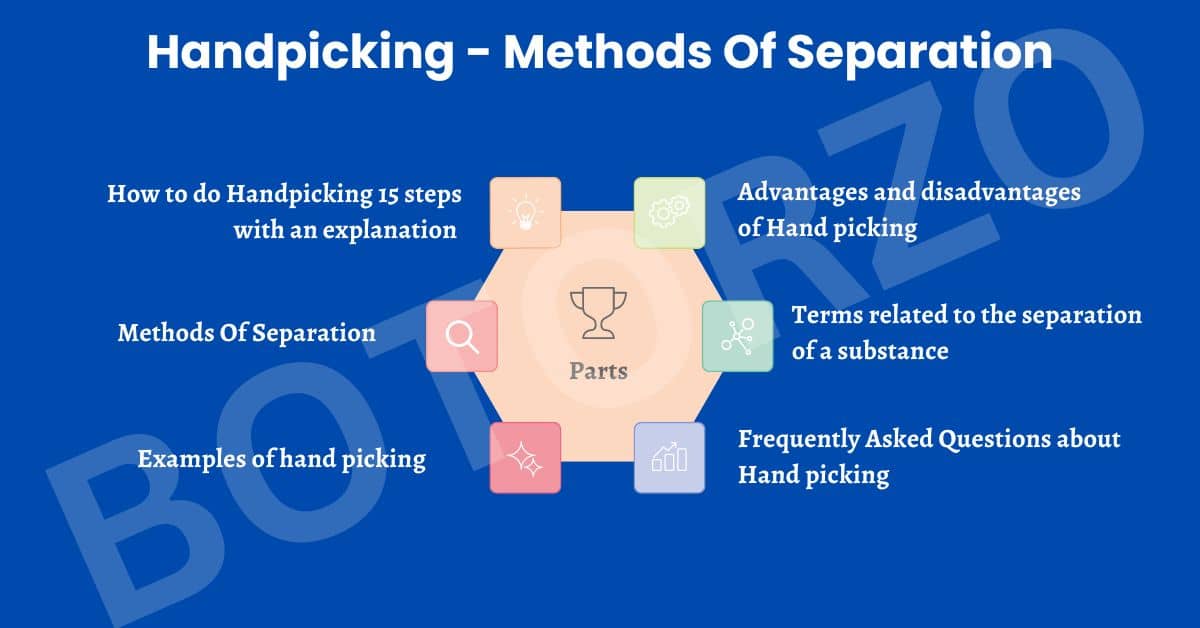
Handpicking is a form of separation in which materials are physically separated depending on their qualities. It is a simple and successful process for separating materials that cannot be separated by conventional means that have been used for ages.
Handpicking is a technique for sorting items depending on their size, shape, texture, density, or colour. It is frequently used to separate materials like stones, metals, and grains in the agriculture, mining, and construction sectors.
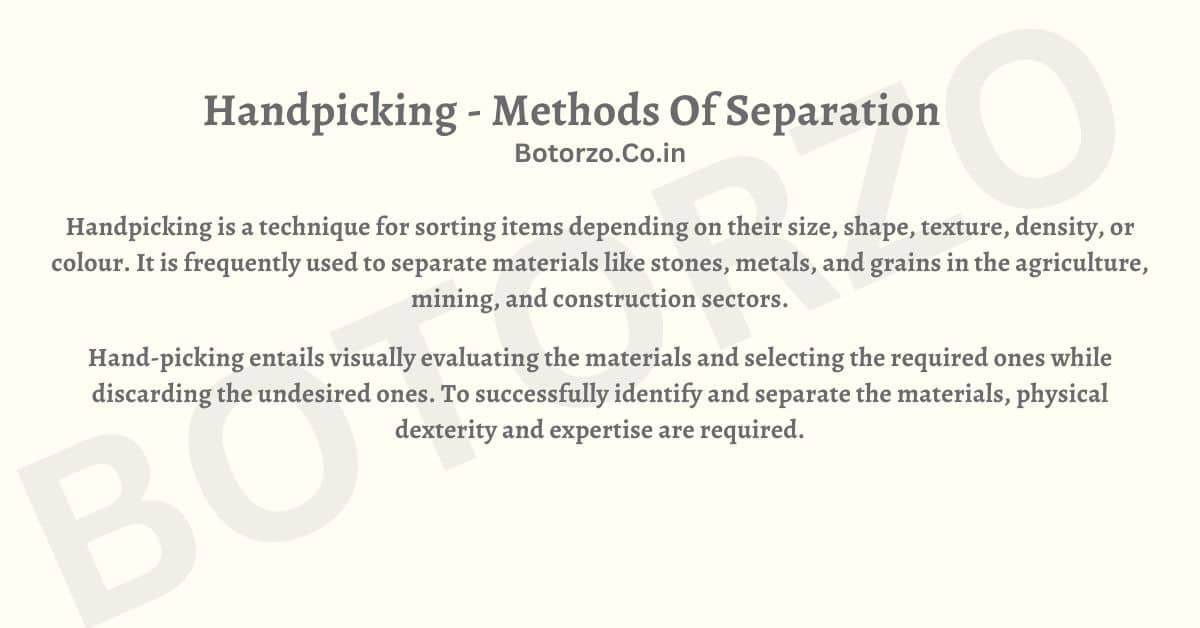
Hand-picking entails visually evaluating the materials and selecting the required ones while discarding the undesired ones. To successfully identify and separate the materials, physical dexterity and expertise are required.
Hand-picking is a low-cost, environmentally friendly separating process that requires no additional equipment or chemicals. It is, however, time-consuming and labour-intensive, rendering it unsuitable for large-scale operations.
How to do Hand-picking 15 steps with explanation – Methods Of Separation
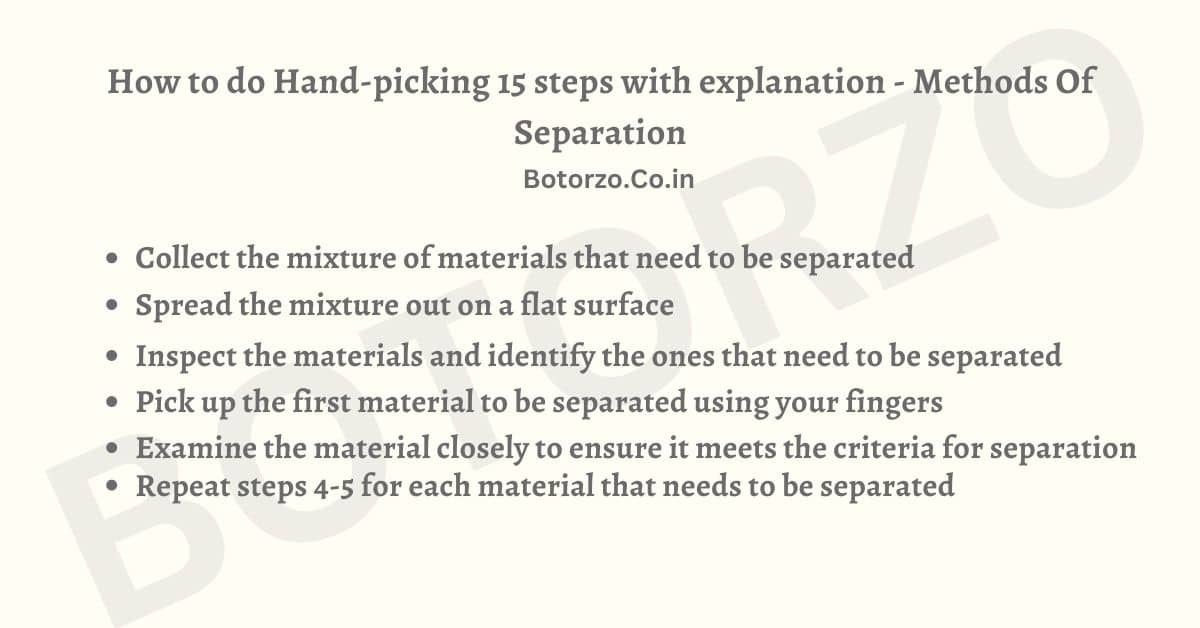
- Collect the mixture of materials that need to be separated. For example, this could be a collection of stones of different sizes.
- Spread the mixture out on a flat surface, such as a table or a tray, so that all the materials are visible. This will make it easier to identify and separate the materials.
- Inspect the materials and identify the ones that need to be separated. For example, in the case of stones, you may want to separate the larger stones from the smaller ones. You can also separate materials based on their colour, texture, shape, or any other physical property that distinguishes them.
- Pick up the first material to be separated using your fingers or a pair of tweezers. This will allow you to examine the material closely and determine whether it meets the criteria for separation.
- Examine the material closely to ensure it meets the criteria for separation. For example, if you are trying to separate larger stones from smaller ones, you would pick up a larger stone and make sure it is not too small. If it meets the criteria, set it aside in a separate container or pile.
- Repeat steps 4-5 for each material that needs to be separated. This can be a time-consuming process, especially if the mixture contains many different materials.
- Once all the desired materials have been separated, examine the remaining mixture to see if any other materials need to be separated. If so, repeat steps 4-6 as necessary.
- If the mixture contains any unwanted materials, such as debris or dirt, remove them and dispose of them properly.
- If you are separating organic materials, such as seeds or fruits, it is important to wash them thoroughly to remove any dirt or debris before handpicking.
- If you are separating materials that are fragile or delicate, such as flowers or leaves, use a soft brush or your fingers to handle them gently and avoid damaging them.
- If you are separating materials that are sticky or difficult to handle, such as gum or tar, you can use a solvent or a cleaning agent to loosen them before handpicking.
- If you are separating materials that are hazardous, such as chemicals or radioactive materials, it is important to follow proper safety procedures and wear protective gear, such as gloves and a mask.
- Once all materials have been separated, dispose of any unwanted materials or recycle them if possible.
- Clean and sanitize the surface and tools used for handpicking to prevent contamination and ensure that they are ready for future use.
- Store the separated materials in appropriate containers or locations to prevent them from mixing with other materials and maintain their quality and integrity.
examples of handpicking
Here are some examples of handpicking as a method of separation:
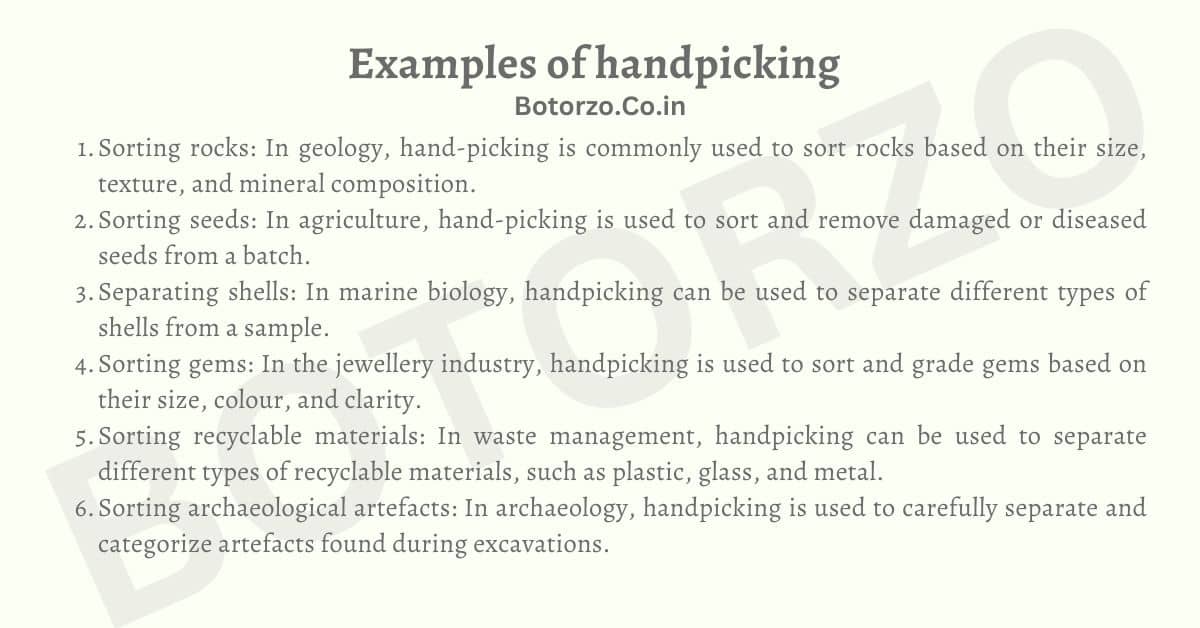
- Sorting rocks: In geology, hand-picking is commonly used to sort rocks based on their size, texture, and mineral composition.
- Sorting seeds: In agriculture, hand-picking is used to sort and remove damaged or diseased seeds from a batch.
- Separating shells: In marine biology, handpicking can be used to separate different types of shells from a sample.
- Sorting gems: In the jewellery industry, handpicking is used to sort and grade gems based on their size, colour, and clarity.
- Sorting recyclable materials: In waste management, handpicking can be used to separate different types of recyclable materials, such as plastic, glass, and metal.
- Sorting archaeological artefacts: In archaeology, handpicking is used to carefully separate and categorize artefacts found during excavations.
- Separating spices: In the food industry, hand picking can separate spices based on their quality and size.
- Separating precious metals: In mining, hand-picking can be used to separate precious metals, such as gold or silver, from other minerals.
Read More Separation’s Methods
advantages and disadvantages of Handpicking – Methods Of Separation
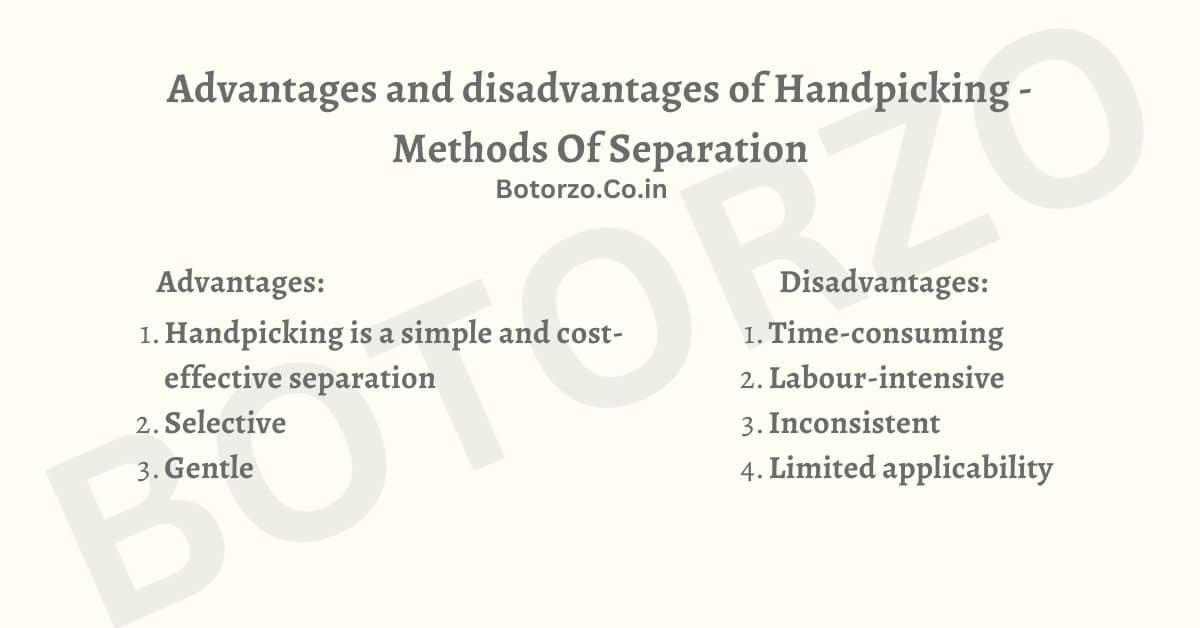
Handpicking is a process of separation in which desirable elements are manually extracted from a mixture using fingers, tweezers, or other instruments. Here are some benefits and drawbacks of hand-picking as a separation method:
Advantages:
- Handpicking is a simple and cost-effective separation.
- Selective
- Gentle
Hand-picking is a simple and cost-effective separation method because it does not require any specialised equipment or chemicals. This makes it an excellent choice for separating mixtures when specialised equipment or chemicals are unavailable or too expensive.
Selective: Hand-picking enables the separation of items based on physical qualities such as size, shape, colour, and texture. As a result, it is an excellent choice for separating mixtures containing elements with unique physical qualities that can be clearly identified and selected by hand.
Gentle: Handpicking is a gentle separation procedure that is effective for separating fragile or delicate materials that may be harmed by other methods. Hand-picking, for example, is widely performed to extract flowers or leaves off stems without hurting them.
Disadvantages:
- Time-consuming
- Labour-intensive
- Inconsistent
- Limited applicability
Handpicking may be time-consuming, especially when separating mixes containing a high number of elements.
Hand-picking is labour-intensive, making it unsuitable for sorting huge volumes of materials.
Hand-picking is prone to human mistakes, which can result in discrepancies in the separation process.
Handpicking has limited use since it is ineffective for separating objects that are too tiny, too similar in appearance, or too dangerous to handle physically.
frequently Asked Questions about Hand picking
-
What types of mixtures can be separated by hand-picking?
Handpicking is best suited for separating mixtures with distinct physical properties.
-
Can handpicking be used to separate small particles?
Handpicking is not effective for small particles; other methods such as sieving are better.
-
Is a hand picking method of separation reliable?
It can be reliable if done carefully but is subject to human error.
-
Can hand picking separate hazardous materials?
Not suitable for hazardous materials that require protective gear.
-
Is handpicking fast and expensive?
It can be slow and labour-intensive but is relatively inexpensive.
-
Can hand-picking be automated?
No, it’s a manual process, but tools like tweezers can assist.
-
What are some examples of materials that can be separated by handpicking?
Materials that can be separated by hand-picking include rocks, gems, shells, and seeds.
-
How does hand-picking compare to other methods of separation?
Hand-picking is a simple and low-cost method of separation but can be time-consuming and less precise than other methods like chromatography or electrophoresis.
-
What are some tips for effective handpicking?
Wear gloves to protect your hands, use good lighting, and take breaks to avoid eye strain. Also, separate materials into categories to make the process more efficient.
Our Another Domains Vidyapedia.in And Uietmdu.in

Comments (1)
Methods of Separation Of Substance with 15 different activities - Botorzosays:
October 29, 2023 at 6:46 pm[…] Handpicking is a basic way of separating material that involves picking individual particles of a mixture out by hand. This approach is frequently employed for big particles or chemicals that may be recognised by size, shape, or colour. […]